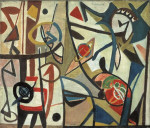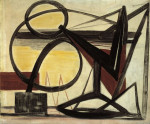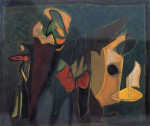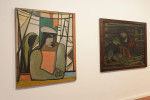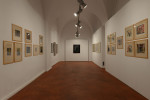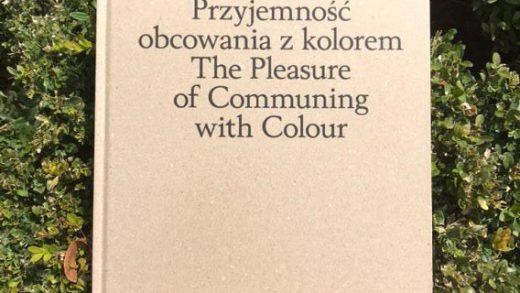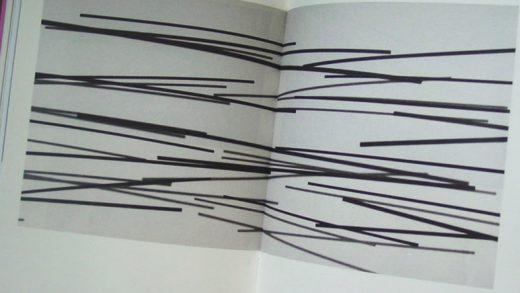opening: 6.05.2016, at 7:00 PM
exhibition until 10.06.2016
organizer:
Galeria Piekary
ul. Św. Marcin 80/82, Poznań
CK Zamek, Dziedziniec Różany

![]()
exhibition open Monday-Friday 10:00 AM-6:00 PM
admission always free
Bogusław Szwacz was born in 1912 in Leżajsk, but moved to pursue higher education in Cracow (1931–1939) where he graduated in 1939 from the Academy of Fine Arts. After the war, he was associated with the milieu of Cracow artists; from 1946 to 1947 Szwacz was a member of the Young Visual Artists Group, along with Maria Jarema, Tadeusz Kantor, Jadwiga Maziarska, Erna Rosenstein, Kazimierz Mikulski, Jerzy Nowosielski, Tadeusz Brzozowski and Jerzy Skarżyński.
Exhibition of Contemporary French Painting and Drawing, held in late June – early July 1946 at the Palace of Arts in Cracow proved to have a tremendous impact on the work of Bogusław Szwacz and other artists of the group. The show included works by such artists as Bazaine, Fougeron, Gischia, or Mignon, but there were numerous others, too. The same year and at the same venue, Szwacz contributed to the Exhibition of the Young Visual Artists Group, showing five of his paintings, including Pieta, Don Quixote, Little Girl, and Buffalos, as well as eight works on paper. The exposition drew quite a response in the newspapers; Stanisław Skosień wrote about the pieces exhibited by Szwacz as follows:
The oeuvre of Bogusław Szwacz ushers one into a thoroughly different world […] in that they strive to find the most diverse forms to manifest varied moods: a fairytale one (Don Quixote), fantastic-exotic (Buffalos), intimate (the intriguing Nude) or the quality of the folk primitive (in what is perhaps the most profound of his paintings, Pieta). His works are homogenous colour compositions, where the individual surfaces of colour seek—under perfect discipline—to define the mood they render. In the drawings, such a coordinating role is entrusted to a red-black line, which Szwacz employs with tremendous deftness. All in all, this is multifaceted art, replete, and disquieting at times.[1]
October 1946 saw the formation of a nationwide group of modernist painters (group of modern visual artists, initially referred to as the group of progressive visual artists), among whom there were Tadeusz Brzozowski, Maria Jarema, Tadeusz Kantor, Jadwiga Maziarska, Kazimierz Mikulski, Jerzy Nowosielski, Erna Rosenstein, Jonasz Stern, Bogusław Szwacz and Tadeusz Łakomski from the Cracow milieu, Teresa Tyszkiewicz, Stefan Wegner, Władysław Strzemiński from Łódź, Leokadia Bielska-Tworkowska, Helena Krajewska, Juliusz Krajewski, Maria Łunkiewicz, Henryk Stażewski, Janina Brosz-Włodarska and Marek Włodarski from Warsaw.
Subsequently, Bogusław Szwacz exhibited his works at the 2nd Winter Salon organized in December 1946 by the Society of Friends of Fine Arts (TPSP) at the Municipal Museum in Radom, then again at the Palace of Arts in Cracow during the 2nd National Winter Salon of the Association of Polish Visual Artist, and at the Palace of Fairs in Poznań, as part of the 3rd National Salon of Painting, Sculpture, and Graphic Arts. The year 1947 saw Szwacz move to Warsaw, while in 1949 the artist joined the Club of Young Artists and Scientists, with Henryk Stażewski, Władysław Strzemiński, Jan Lenica, Zbigniew Dłubak, Wojciech Fangor, Marian Bogusz, Marek Włodarski and Ignacy Witz. It was with that Club that he presented his achievement at a 1947 show of contemporary painting. Then, in 1947-1948, Szwacz left for a fellowship in Paris, where he joined the group Le Surréalisme Révolutionnaire, and became correspondent of its periodical. Throughout 1948, Szwacz remained intensely active, joining Henryk Stażewski, Marek Włodarski, Maria Jarema, Tadeusz Kantor, Kazimierz Mikulski, Jerzy Nowosielski, Teresa Tyszkiewicz, Stefan Wegner for a show of contemporary Polish painting Near Kraków in New York, which subsequently visited Chicago and Washington, and taking part in Prises do Terre. Peintres et Sculpteurs de l’Objectivité at the Galerie René Breteau in Paris.
They were holding an exhibition at the Galerie René Breteau, rue Bonaparte 70, and asked that I participate. […] Indeed, abstraction and surrealism are the most robust tendencies in the contemporary culture of Paris. There are attacks from surrealists such as S. Dali and Breton, whom the new revolutionary surrealism condemns for their anti-social approach to life today. Communism is the actual foundation for surrealists-revolutionaries. Poets and writers make a great contribution in that respect. Their art needs a social-political underpinning, a footing. Out of necessity, visual artists take advantage of that base, but I think that plastic arts will go their own way and may soon forge the right form in art.[2]
On top of that, in 1948 Szwacz appeared in Karlovy Vary, České Budějovice, and Prague at the Young Polish Artists show and took part in the III Salon des Réalités Nouvelles in Paris. Subsequently, in late 1948 and early 1949, the artist showed three oils, ten watercolours and a portfolio of drawings at the 1st Exhibition of Modern Art in Cracow.
In the ceaseless striving to know truths in the world of phenomena that surround us and those within human nature, since the inception of culture until today the human has not confined themselves to the skill of imitating and copying forms observed in nature, but desired to give vent to the longings of their creative imagination while detached from the outer garb of those phenomena. Therefore, since the birth of human culture two tendencies have emerged in art: a naturalist and an anti-naturalist one, both being a product of the realistic stimulus of human nature. The art of the primitive peoples and folk art represent a harmonious unity of those two tendencies, occurring simultaneously on all continents of the globe. Our age has appreciated that in a measure it deserved, and contemporary art is a consequent development stage of the two tendencies.[3]
At the time, Bogusław Szwacz became senior lecturer at the Higher State School of Plastic Arts in Warsaw. In 1949, invited by the Dutch Experimental Group, the artist travelled to Amsterdam to take part in an exhibition of modern art there. However, the enthusiasm of young artists, sparked by the 1st Exhibition of Modern Art, was soon bitterly doused, as in 1949 Socialist Realism was promulgated as the official style in Polish art. Szwacz, as a member of the faculty at the Higher State School and member of the Polish United Workers’ Party as actively involved in artistic life in the first half of the 1950s, contributing in major exhibitions of that period: the National Exhibition of Visual Arts “Artists for Peace” (Zachęta 1950), 2nd National Exhibition of Visual Arts (Zachęta 1951–1952), 3rd National Exhibition of Visual Arts (Zachęta 1952–1953) and the 4th National Exhibition of Visual Arts (Zachęta 1954). In the wake of the so-called Thaw, Bogusław Szwacz showed a number of abstract works—the first to be exhibited in years—at the exhibition organized at the Writers’ Association Club in 1955. Jerzy Ficowski wrote thus in his account:
What does Szwacz express in my opinion? Human emotional states, the feelings, the rapture over the incalculable possibilities of the matter whose creator dictates the laws, the mood of mental sensation laden with the optimism of conquest, which after all can be conveyed somehow, not necessarily via anecdote. Szwacz does it in a variety of ways: it is in different rhythms and tonalities that the surfaces of his paintings come alive. I have used the terms originating from music deliberately, since I can see numerous affinities and analogies between Szwacz’s art and music: the lay of the patches and lines, the mutual relationships of colours, the dynamics of the whole—all that is in some way musical.
The oeuvre of Bogusław Szwacz has been by audiences at several solo exhibitions in Poland, while the works themselves may be found in museums as well as in private collections in the country and abroad. It may be added that from 1954 to 1982, the artist held the position of assistant professor the Faculty of Sculpture, Academy of Fine Arts in Warsaw, becoming Associate Professor in 1983. Bogusław Szwacz died in 2009 in Warsaw.
References:
J. Chrobak, “Bogusław Szwacz 1946–1949,” [in:] Bogusław Szwacz. Obrazy i prace na papierze z lat 1946-1950, exhibition catalogue, Poznań: Galeria Piekary, 2004, pp. 29–32.
[1] S. Skosień, Trybuna Robotnicza, November 1st, 1946.
[2] B. Szwacz in a letter to T. Kantor dated March 5th, 1948, [in:] Bogusław Szwacz. Malarstwo 1946–1956, Kraków: Cricoteka, 2004, p. 49.
[3] B. Szwacz, “Moje wypowiedzi o sztuce,” [in:] I Wystawa Sztuki Nowoczesnej. Pięćdziesiąt lat później, Kraków: Starmach Gallery, 1998, p. 271.
Magdalena Piłakowska
media patronage:


